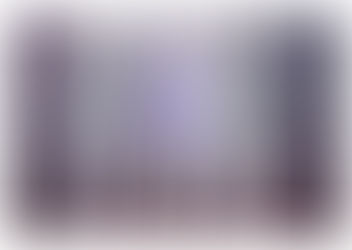Kim Thittachai Artist Page
- Pg 14-15
- Mar 14, 2016
- 4 min read


In a youtube video I watched on Kim Thittachai she creates a sample like this using shapes of tyvek. https://www.youtube.com/watch?v=nq6Z8nd72WU
I loosley cut out four different sized circles from a piece of tyvek. The neatness of the circles were not essential as once tyvek is applied to head, the material will become distorted. I layed down some newspaper to protect my surroundings and painted a thin layer of blue paint on the smallest circle using a dry paintbrush. A thin layer is nessercary when painting tyvek as too much paint will result in the heat being unable to transfer through.
The second smaller circle is a mix of blue and white paint thinly spead to contrast the colour on top. The other two circles are different shades of blue achieved by different ratios of blue and white paint mixed together.

Once the shapes were flly dry, I secured them with a series of french knots using two different shades of blue. I inittally was using a standard size embroidery needle. I found this was too thin to easily pierce through all layers of tyvek so I used a thicker, stronger needle. I found using the stronger needle produced neater shaped knots as to the thinner needle. If I was to recreate this sample I will make sure to use an appropriate needle from the start so all the knots look to a high standard. I used french knots as they compliment the flower shape which will be the final form of this sample.

I was now ready to apply heat to this sample to create a warped appearance. Before doing anything, I made sure my work space was clear from any hazzards as I was working with an iron. I cleared any liquid, electricals and fire hazzardous objects so I was working in a safe environment. I wasn't sure what the best setting to have my iron on as the iron I used is colour coded from blue - red rather than a dial. To prevent any burning I set the iron to the lowest heat setting (blue). I sandwhiched my smaple in between to pieces of parchment paper. The parchment paper is used so the iron is not directly in contact with the sample. It prevents any melted substances from transfering onto the iron and surface. I very lightly moved the iron over the parchment paper, not dirctly pressing onto it. I flipped the sample over, ironed and then repeated this step a few times, being cautious when flipping the sample over not to burn myself. The blue setting wasn't a high enough temprature to affect the tyvek. I moved up two heat settings (purple) where I began to see progress. The smallest circle on top shrunk and warped the most as it had the most exposure to the heat. The twi inner circles were harder to distort as they were protected by other layers.
This is my favourite sample I created inspired by Thittachai. To develop this technique I could create a sample linking to my theme.


Kim Thittachai is all about experimenting with new ideas and not using the same processes as another person. This sample I created inspired by Thittachai's idea of innovative experimentation.
I layed down a piece of newspaper to protect my surface for when I want to incorporate it in my sample. Using blue and white mixed acrylic paint, I used a dry brush to cover the tyvek, thick enough so it will pick up the newsprint but not too thick so it block out any heat. I then flipped the tyvek over and applied pressure using my hands so the tyvek was pressed against the news print. I wanted to wait a couple of minutes before peeling the tyvek off so I loosly applied some blue paint to the up front side. This would mean my sample will be double sided with two different finishes. I peeled away the tyvek and the news print had stuck to the paint. I like the way the news print hasn't covered the whole material so you can still see the blue colour. The way the news print has torn also gives a great distressd look which will add to the aestetics of the sample. the material was left to dry before any further processes.
I used the same parchment paper as I did for my previous sample as there was no need to waste resources. I switched my iron onto the green setting which was in between the blue and purple just in case this was enough heat for this sample. I used the same technique with my iron as I did for my last sample, gently moving the iron over the material. This setting was not hot enough to distort the sample at all, it only caused it to roll up.
I changed the setting to purple and tried the technque again which produced the bubbled effect I was hoping for.

I the used a lighter to curves any corners which I missed with the iron. When using the lighter, I ensured there was no fire hazzards surrounding me. I stood by an open window when burning the material incase it caught fire.
I am overall happy with this experimentational sample as it is a unique attempt at Thittachai's style. I like the fact this piece is double sided to show off the different styles this process can produce.
To develop my responses to Thittachai's work I will combine synthetic materials such as polyester organza with tyvek to see the appearance of numerous materials combined. I will also use a different piece of equiptment to see the different outcomes they produce. I am also going to experiment with free hand machine embroidery as Thitachai likes to use this as a way of securing fabrics together.
























Comments